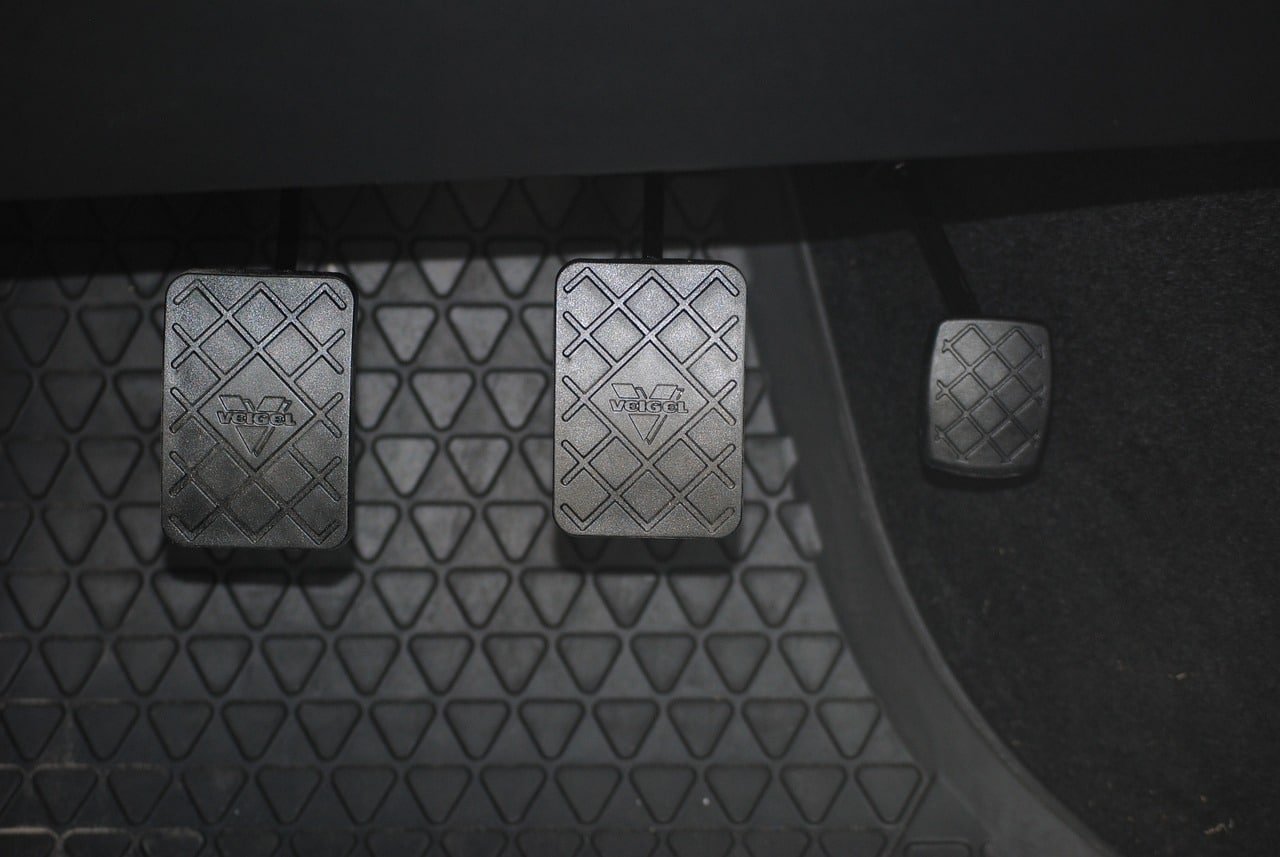
Understanding Forward Bay Parking: A Comprehensive Guide
Forward bay parking is a manoeuvre that involves driving your vehicle directly into a parking bay, aligning it within the designated lines. This technique is essential for learner drivers to master, as it is not only a requirement for the driving test in many jurisdictions but also a valuable skill for everyday driving situations. Unlike reverse bay parking, which involves backing into a space, forward bay parking is often perceived as more intuitive for new drivers due to the direct line of sight when entering the bay.
Why Is Forward Bay Parking Important?
For learner drivers, becoming proficient in forward bay parking is crucial. It demonstrates control, precision, and awareness of the vehicle’s dimensions, all key aspects assessed during the driving test. Moreover, mastering this manoeuvre enhances your confidence in handling various parking scenarios in daily driving.
Differences Between Forward and Reverse Bay Parking
- Visibility: Forward bay parking offers immediate visibility upon entering the bay, whereas reverse bay parking provides better visibility when exiting.
- Manoeuvrability: Reverse bay parking typically allows for easier manoeuvring and alignment within the bay lines due to the steering dynamics when reversing.
Optimal Practice Times
The best time to practice forward bay parking is during off-peak hours in less crowded parking areas. This allows for a stress-free environment where you can focus on mastering the technique without the pressure of navigating around other vehicles or pedestrians.
Finding Reliable Resources
At Smart Drive UK, we provide comprehensive resources and personalised instruction to help you master forward bay parking. Our experienced instructors offer one-on-one lessons tailored to your learning pace, ensuring you gain the confidence and skills needed to excel in your driving test and beyond.
The Visibility Factor: Advantages and Challenges

When you’re learning to drive, understanding the visibility factor in parking manoeuvres is crucial. At Smart Drive UK, we emphasise the importance of visibility, especially when it comes to forward bay parking. This method, while seemingly straightforward, presents unique visibility advantages and challenges.
Why Visibility is Better When Parking Forwards
Parking forwards into a bay offers the immediate advantage of a clear, unobstructed view of the parking space as you approach. This direct line of sight allows for easier alignment and positioning within the bay lines, reducing the risk of misjudgment that could lead to parking errors.
Main Visibility Challenges When Reversing Out
However, the challenge arises when it’s time to leave the parking space. Reversing out after parking forwards can limit your visibility, making it harder to see approaching vehicles and pedestrians. This reduced visibility increases the risk of accidents or near-misses.
Overcoming Visibility Issues
To overcome these visibility issues, we teach our learners to utilise all available mirrors and to perform thorough shoulder checks before reversing. It’s also important to reverse slowly, allowing more time to react to any unforeseen obstacles.
Focusing Attention for Improved Visibility
During forward bay parking, your attention should be focused on:
– The front and sides of the parking bay as you enter, ensuring you’re aligned correctly.
– Your mirrors and blind spots when preparing to reverse out, to ensure the way is clear.
– Pedestrians and other vehicles, maintaining awareness of your surroundings at all times.
By understanding and addressing the visibility factor, you can enhance your parking skills, making you a safer and more confident driver.
Selecting the Right Parking Bay: Strategy and Considerations
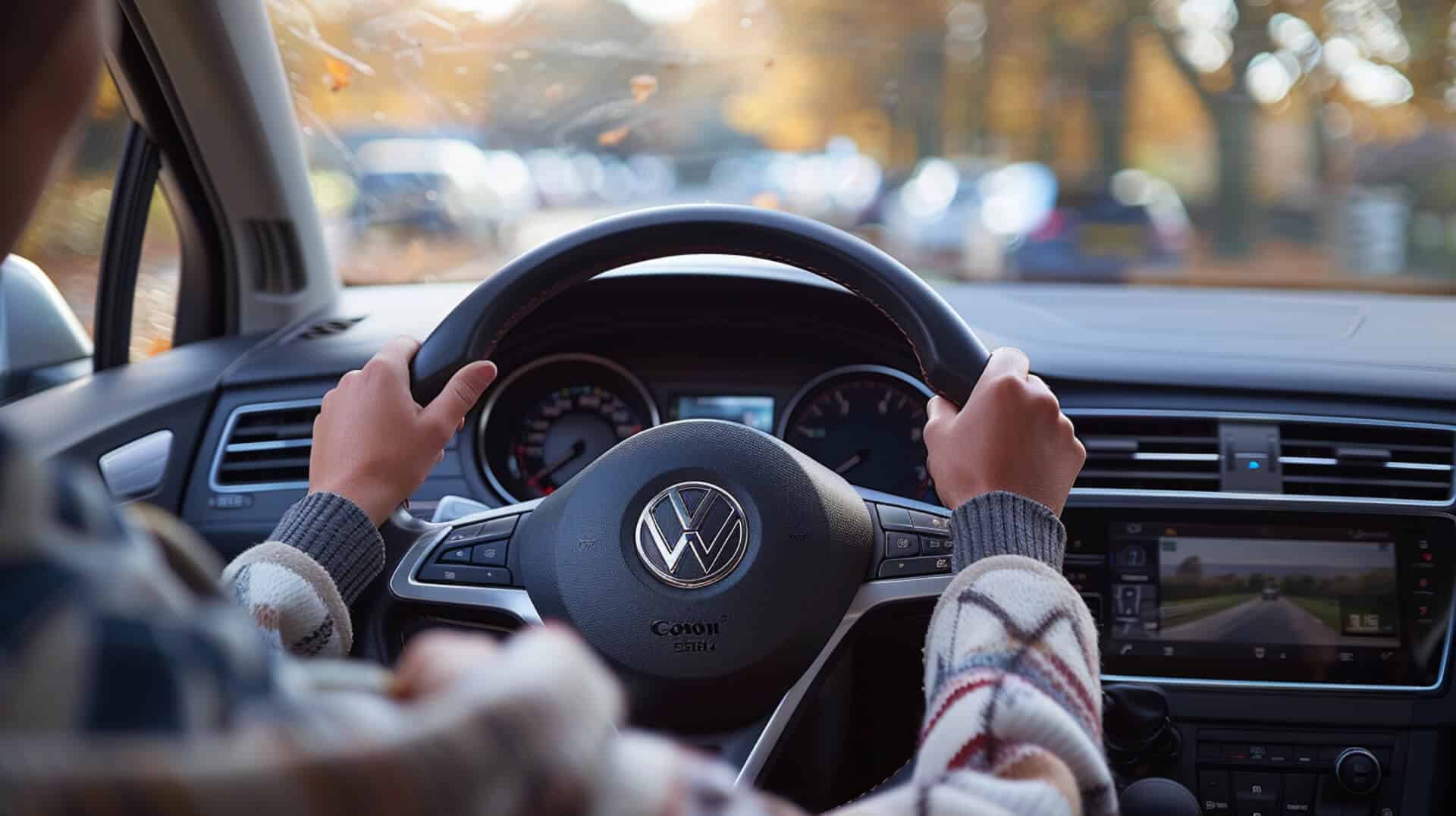
Choosing the appropriate parking bay is a critical step in forward bay parking, one that can significantly influence the ease and safety of your parking experience.
Factors to Consider When Selecting a Parking Bay
When selecting a parking bay for forward parking, consider the following:
– Size of the bay: Ensure the bay is suitable for the size of your vehicle.
– Surrounding vehicles: Opt for a bay with smaller vehicles parked on either side, if possible, to increase your visibility and space for manoeuvring.
– Traffic flow: Choose a bay in a less busy area to reduce the risk of accidents while parking and exiting.
Importance of Parking Bay Choice
The choice of parking bay is crucial for several reasons:
– It affects the ease of entering and exiting the bay.
– Proper selection minimises the risk of damage to your vehicle and others.
– It influences your confidence and comfort while parking.
Environmental Considerations
Environmental factors, such as the slope of the parking area and weather conditions, can also affect your choice. For instance, parking on a flat surface is preferable, especially for beginners, to avoid the additional challenge of controlling the vehicle on a slope.
Practising in Real-World Scenarios
We encourage our learners to practice selecting the right parking bay in various real-world scenarios, such as:
– Busy shopping centre car parks
– Quiet residential areas
– Different times of the day to experience varying levels of traffic and parking availability
This practice is essential for building the skill and confidence needed for successful forward bay parking.
Mastering the LADA and MSPSL Routines for Effective Parking

In the journey to becoming a proficient driver, understanding and applying the LADA and MSPSL routines are fundamental. At Smart Drive UK, we emphasise these routines as they are pivotal in ensuring a smooth and safe parking manoeuvre, especially when it comes to forward bay parking.
What are the LADA and MSPSL Routines?
LADA stands for Look, Assess, Decide, and Act. This routine encourages a systematic approach to any driving situation, ensuring that you’re always aware of your surroundings and can make informed decisions on the road.
MSPSL refers to Mirror, Signal, Position, Speed, and Look. It’s a comprehensive routine that guides drivers on how to approach and execute manoeuvres, including parking, by ensuring all necessary steps are methodically followed for safety.
Why These Routines are Crucial
These routines are crucial because they provide a structured approach to driving manoeuvres, reducing the likelihood of mistakes and accidents. For forward bay parking, they ensure that you’re constantly assessing your environment, making appropriate decisions, and executing your manoeuvres with precision and safety in mind.
Integrating Routines into Forward Bay Parking Practice
To integrate these routines into your forward bay parking practice:
– Start with LADA: Always begin by looking around and assessing your surroundings. Decide on your action based on what you see and then act accordingly.
– Follow with MSPSL: Use your mirrors to check for other vehicles and pedestrians, signal your intention to park, position your vehicle correctly, adjust your speed as necessary, and look around one last time before completing the manoeuvre.
Aligning Your Vehicle Correctly: The Role of Reference Points
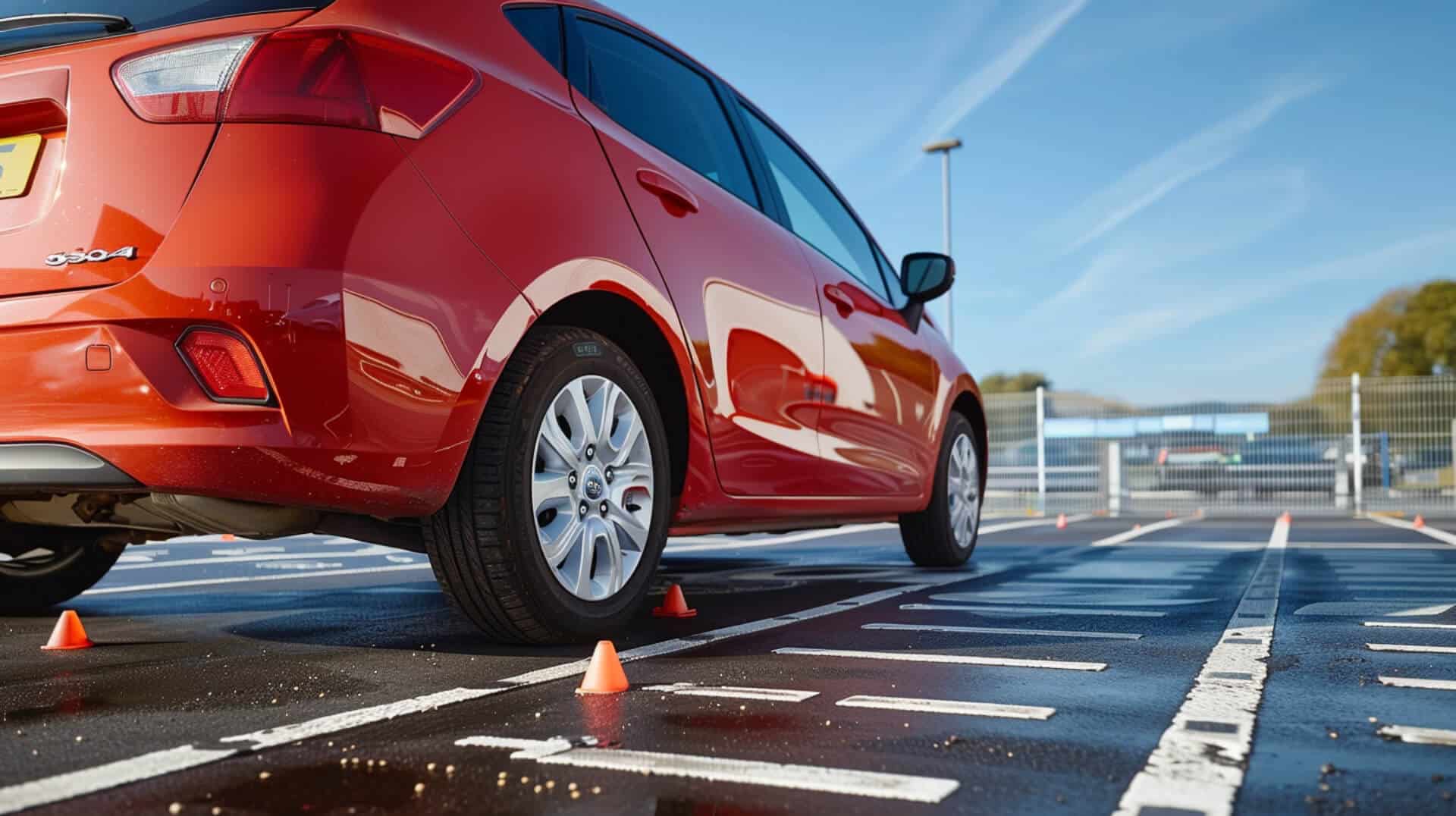
Understanding how to align your vehicle correctly is a fundamental aspect of forward bay parking. At Smart Drive UK, we understand the importance for some people of using reference points to achieve this alignment. Reference points are specific markers on your vehicle that you align with fixed points in the environment, helping you accurately position your vehicle within a parking bay.
What are Reference Points?
Reference points are visual cues on your vehicle, such as the edge of the windshield or a door handle, that you can align with lines or objects in the parking area to guide your parking manoeuvre. These points are crucial for ensuring your vehicle is centred and properly positioned within the parking bay.
Identifying and Using Reference Points Effectively
To identify and use reference points effectively:
– Familiarise yourself with your vehicle’s dimensions by walking around it and noting key features that can serve as reference points.
– Practice aligning these points with fixed objects in a safe, open space before attempting to park in a real scenario.
– Adjust your seat and mirrors to ensure you have a clear view of these reference points from the driver’s seat.
Adjusting to Different Vehicles
Reference points can differ between vehicles due to variations in size and design. To adjust:
– Take time to learn the new reference points when driving a different vehicle.
– Practice parking in a controlled environment to become comfortable with the vehicle’s dimensions.
Practising with Reference Points
Learners can practice using reference points in various parking scenarios by:
– Using cones or other markers in an open area to simulate parking bays.
– Visiting different types of car parks to experience how reference points apply in diverse settings.
By mastering the use of reference points, you’ll gain confidence in your parking abilities and ensure your vehicle is always well-positioned within the bay.
Precision Steering Techniques for Entering and Exiting the Bay
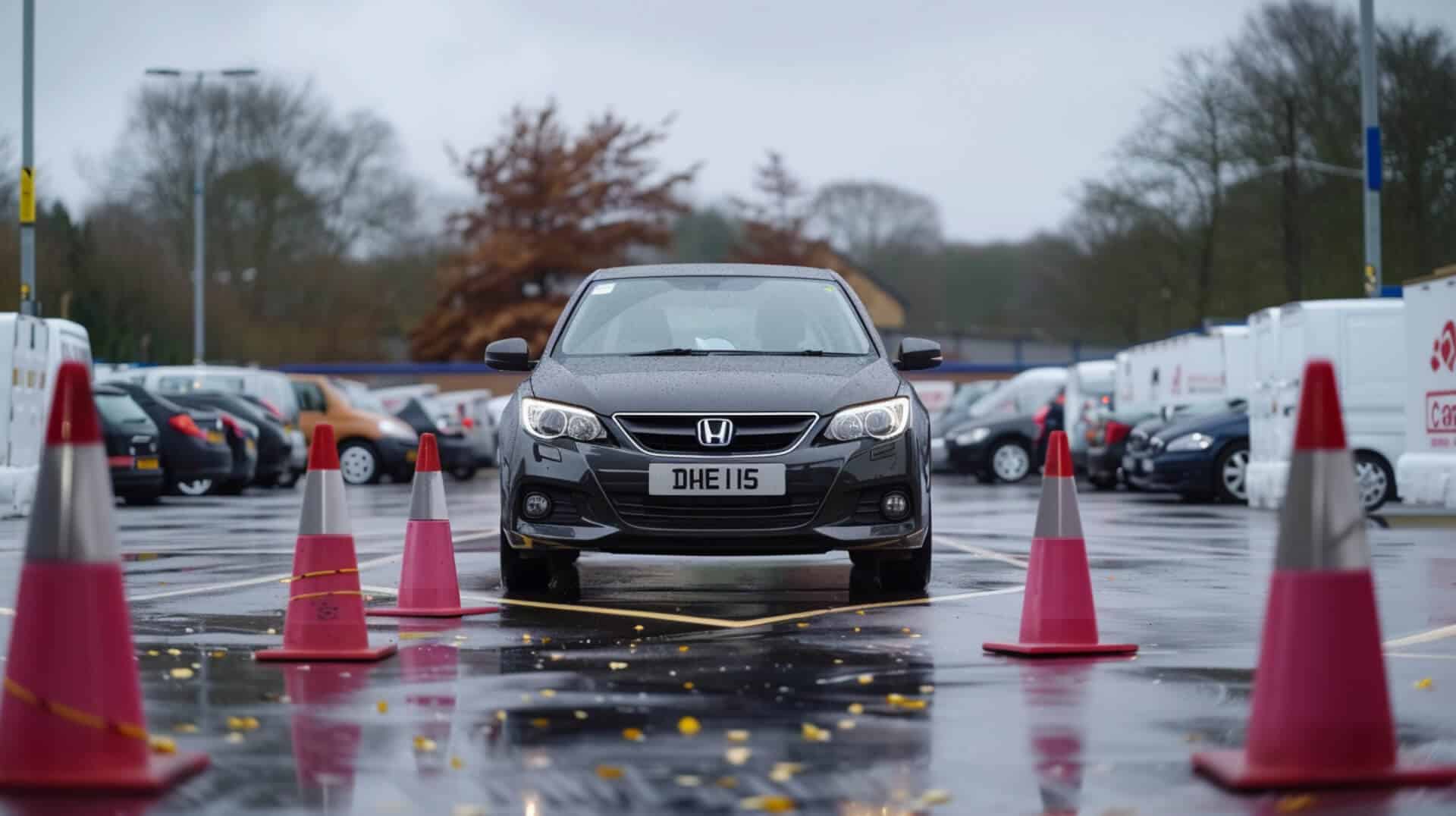
Mastering precision steering techniques is essential for successful forward bay parking. At Smart Drive UK, we focus on equipping you with the skills necessary to navigate parking bays with confidence and accuracy. Understanding the right steering methods can significantly enhance your parking efficiency and safety.
Effective Steering Techniques for Forward Bay Parking
For forward bay parking, the “pull and push” method is highly effective. This technique involves smoothly feeding the steering wheel through your hands without crossing them over, allowing for precise control and adjustment as you enter or exit a parking bay. Additionally, practising “small adjustments” can be crucial. Rather than making large, sweeping turns, small steering adjustments help in aligning your vehicle accurately within the parking bay lines.
Practising Steering Adjustments
To practice steering adjustments for precise vehicle alignment:
– Find a quiet, open space such as an empty car park.
– Set up cones or use existing bay lines as markers.
– Approach the parking bay slowly, focusing on making minor steering adjustments to align your vehicle correctly.
The Importance of Steering Control
Steering control is vital for avoiding unnecessary adjustments once inside the bay. Precise steering helps ensure that your vehicle enters the bay smoothly, reducing the need for corrective manoeuvres that can complicate the parking process.
Adjusting Within Bay Lines: Ensuring Perfect Alignment
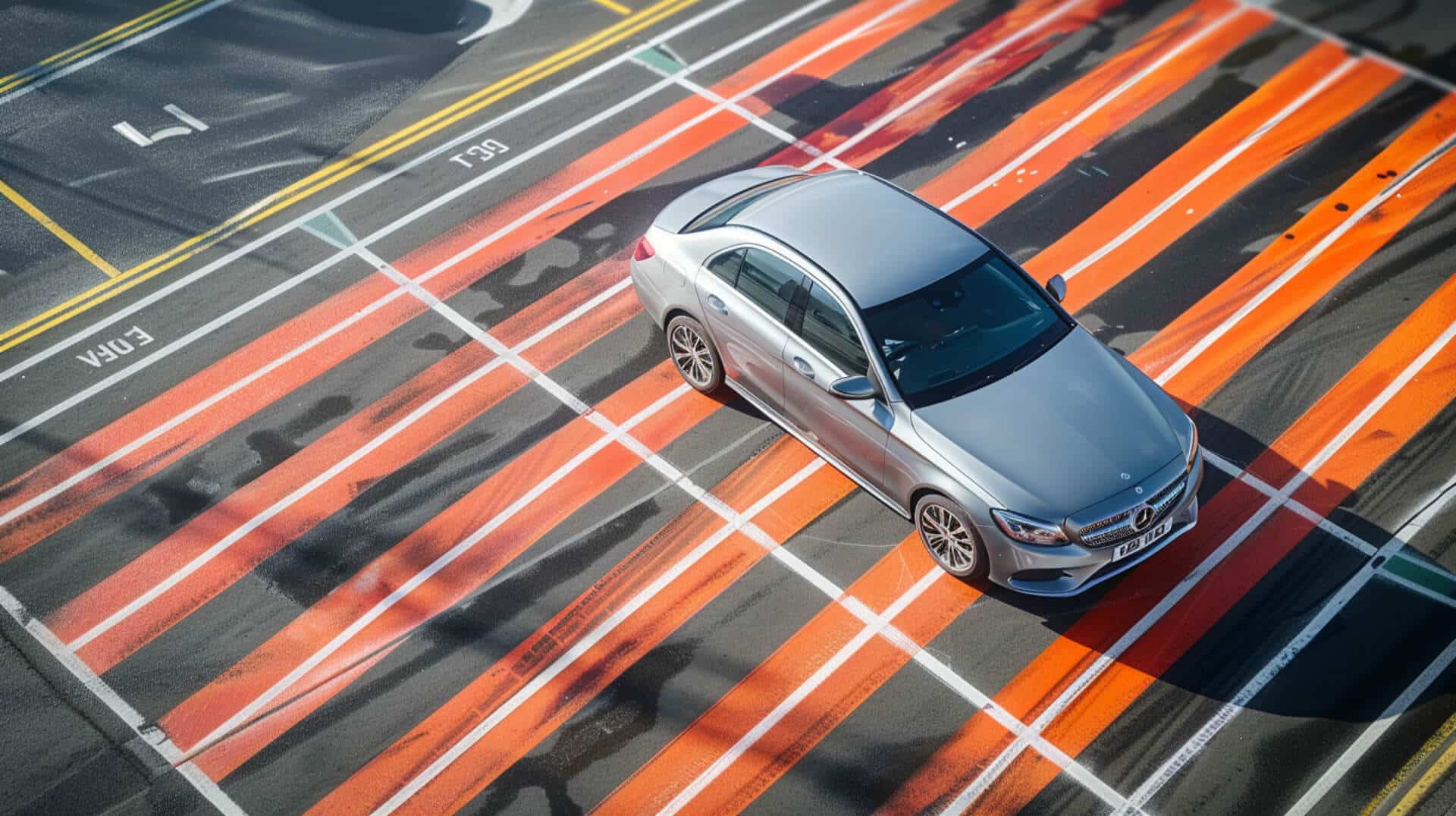
Achieving perfect alignment within parking bay lines is a critical skill for any driver. At Smart Drive UK, we understand that even with careful manoeuvring, your vehicle may not always end up perfectly positioned after the initial attempt at parking. Here, we discuss the steps and practices necessary for making effective adjustments.
Steps for Correcting Alignment
If your vehicle is not perfectly aligned within the bay lines, consider the following steps:
– Assess the Situation: First, assess how your vehicle is positioned relative to the bay lines. Determine which direction you need to adjust: forward, backward, left, or right.
– Make Minor Adjustments: Use small, precise movements to adjust your vehicle’s position. This may involve moving slightly forward or backward, or turning the steering wheel for slight repositioning.
– Recheck Your Position: After adjusting, exit the vehicle and visually check its position within the bay lines to ensure it is correctly aligned.
The Impact of Minor Adjustments
Minor adjustments can significantly enhance the safety and aesthetics of your parking:
– Prevents Damage: Proper alignment minimises the risk of bumping into adjacent vehicles or obstacles.
– Improves Accessibility: Ensures there is adequate space for passengers to enter and exit the vehicle without difficulty.
Practising with Different Vehicle Sizes
Understanding how to adjust for different vehicle sizes is important because:
– Different Dynamics: Larger vehicles may require wider spaces and more significant adjustments due to their size.
– Skill Enhancement: Practising with various sizes improves your adaptability and parking skills across different scenarios.
Safe and Controlled Practice Environments
We recommend practising adjustments in:
– Empty Car Parks: Ideal for beginners, allowing for practice without the pressure of nearby vehicles.
– Driving Schools: Facilities like Smart Drive UK offer controlled environments with professional guidance to help you master these adjustments.
By focusing on these practices, you’ll become proficient in aligning your vehicle within parking bay lines, enhancing your confidence and competence as a driver.
The Importance of Continuous Observation for Safety
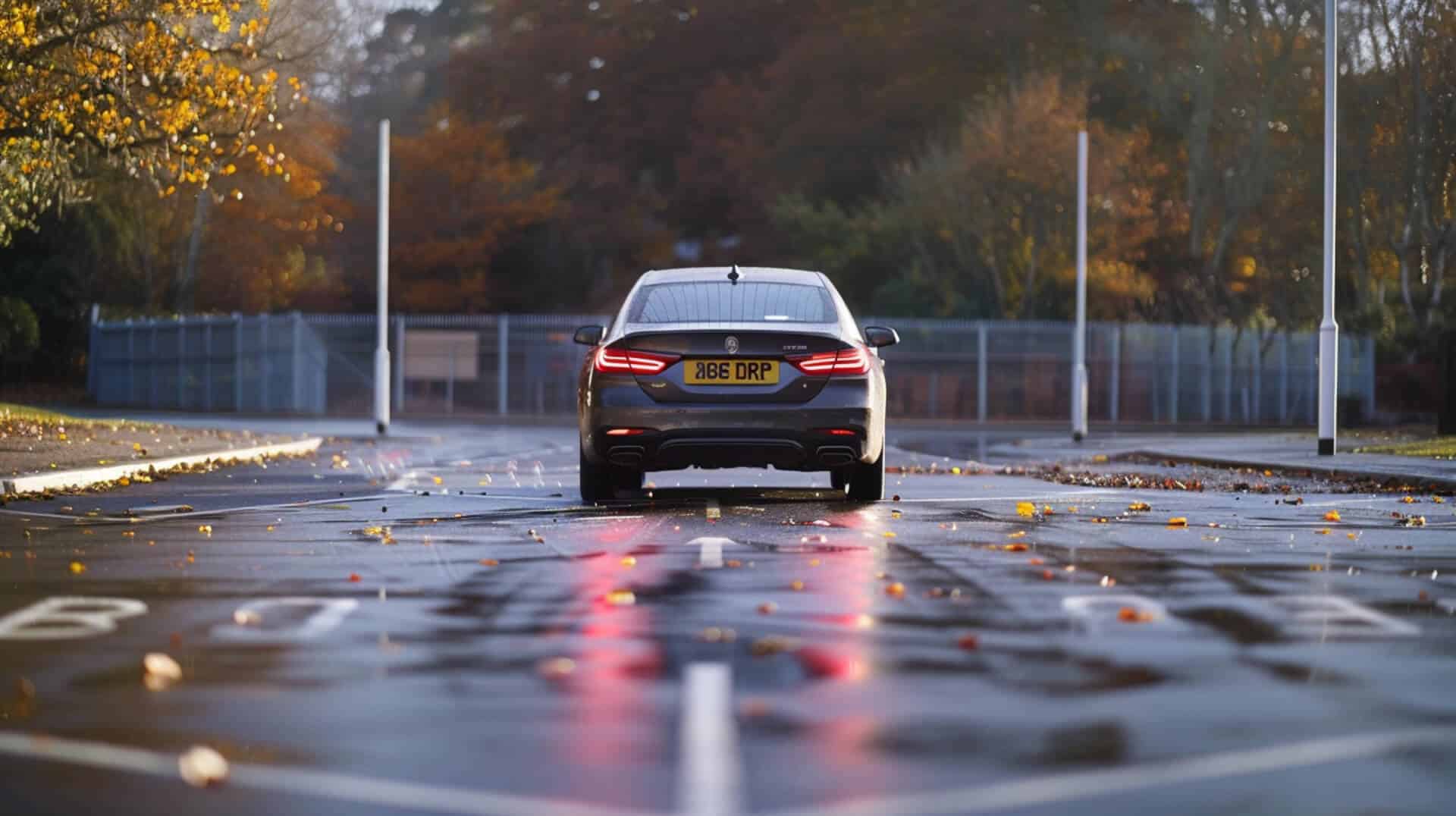
Continuous observation plays a pivotal role in ensuring safety and precision during the forward bay parking process.
What to Observe During Forward Bay Parking
During the forward bay parking process, it’s essential to keep a watchful eye on:
– Surrounding Vehicles: Monitor the movement of vehicles around you to anticipate their actions and adjust your manoeuvres accordingly.
– Pedestrians: Be especially alert for pedestrians moving through the parking area, who may not always be visible from inside the vehicle.
– Obstacles: Look out for any obstacles within or around the parking bay that could impede your parking attempt or pose a risk when exiting the bay.
Enhancing Safety and Precision Through Observation
Continuous all round observation enhances safety by allowing you to:
– React Promptly: Identify and respond to potential hazards before they become a threat.
– Adjust Manoeuvres: Make real-time adjustments to your parking technique based on the current situation.
Awareness of Pedestrians and Other Vehicles
Being aware of pedestrians and other vehicles is crucial because:
– Prevents Accidents: Reduces the risk of collisions with pedestrians and vehicles.
– Promotes Courtesy: Encourages considerate parking habits, ensuring you do not inadvertently block or inconvenience others.
Practising Observation Skills
Learners can practice their observation skills in:
– Busy Car Parks: These areas provide a realistic setting with a mix of vehicles and pedestrians, offering ample opportunity to hone your observation skills.
– Simulated Environments: Driving schools, including Smart Drive UK, offer simulated parking scenarios that mimic real-life conditions, allowing for safe practice.
By prioritising continuous observation, you’re not only improving your forward bay parking skills but also contributing to a safer parking environment for everyone.
Effective Practice Routines for Forward Bay Parking
To effectively master forward bay parking, consider incorporating the following routines into your practice sessions:
– Repetition: Practice the manoeuvre in various parking scenarios to build muscle memory and adaptability.
– Incremental Challenges: Start with larger, easier parking bays and gradually move to tighter spaces as your confidence grows.
– Feedback Loop: Seek feedback from an instructor or experienced driver and use it to refine your technique.
Recommended Frequency of Practice
For optimal improvement, we recommend practising forward bay parking:
– At least twice a week during your initial learning phase.
– Increasing the frequency as you approach your driving test for reinforcement.
The Importance of Consistent Practice
Consistent practice is crucial for:
– Skill Development: Enhancing your precision and control during the parking manoeuvre.
– Confidence Building: Reducing anxiety and increasing your confidence in real-world parking situations.
Finding Safe Practice Environments
Safe environments for practising forward bay parking include:
– Empty Parking Lots: Ideal for beginners, offering a controlled space with minimal distractions.
– Driving Schools: Facilities like Smart Drive UK provide a structured learning environment with professional guidance.
By dedicating time to practice and utilising the resources available at Smart Drive UK, you can achieve mastery over forward bay parking, ensuring you’re well-prepared for your driving test and beyond.
Leveraging Technology: Parking Sensors and Assistance Systems

In the modern driving experience, technology plays a pivotal role, especially when it comes to manoeuvres like forward bay parking. At Smart Drive UK, we recognise the value of integrating technology aids such as parking sensors and assistance systems into our training programmes. These tools not only enhance safety but also boost the confidence of learner drivers.
The Role of Parking Sensors and Assistance Technology
Parking sensors and assistance systems are designed to aid drivers during parking manoeuvres by providing audible or visual cues about the proximity to obstacles. This technology is particularly beneficial for forward bay parking, where visibility can sometimes be limited. These aids help to prevent collisions, ensuring a smoother and safer parking process.
Acclimating to Technology Aids
To become accustomed to using technology aids, we encourage learners to:
– Practice Regularly: Incorporate technology aids into regular practice sessions to understand their feedback mechanisms.
– Understand Limitations: Recognise that while helpful, these aids are supplements to, not replacements for, manual skills and observation.
Balancing Technology Use with Manual Parking Skills
It’s crucial to maintain a balance between relying on technology and honing manual parking skills. Technology can fail or may not always be available, so strong foundational parking skills remain essential. We emphasise the importance of developing these skills alongside technological proficiency.
Understanding Legal Parking Regulations
Legal parking regulations are designed to ensure safety, order, and accessibility on the roads and parking areas. As a learner, you must be aware of:
– Local Parking Laws: These can vary significantly from one area to another and may dictate where and how you can park.
– Signage and Markings: Understanding the meaning of different parking signs and road markings is crucial for compliance.
– Disabled Parking Spaces: Recognising and respecting spaces reserved for disabled individuals is a legal and ethical requirement.
Overcoming Parking Anxiety: Building Confidence Through Practice
Parking anxiety is a common challenge among learner drivers, often stemming from the fear of making mistakes in front of others or causing an accident. At Smart Drive UK, we understand these concerns and offer strategies to help you manage parking anxiety effectively, ensuring it doesn’t hinder your progress towards becoming a confident driver.
Strategies to Manage Parking Anxiety
To combat parking anxiety, consider the following approaches:
– Start Small: Begin practising in less crowded areas before attempting more challenging environments.
– Visualise Success: Before starting your parking manoeuvre, take a moment to visualise successfully completing it.
– Breathing Exercises: Practice deep breathing exercises to calm your nerves before and during parking.
The Role of Practice in Building Confidence
Consistent practice is key to building your confidence. Each successful parking attempt reinforces your skills and reduces the fear associated with the task. Over time, what once seemed daunting becomes second nature, significantly improving your parking skills and overall driving competence.
Seeking Support and Guidance
If parking anxiety persists, remember, you’re not alone. At Smart Drive UK, we offer personalised support and guidance to help you overcome your fears. Our experienced instructors provide a supportive learning environment, tailoring lessons to your individual needs and pace. Don’t hesitate to reach out to us for assistance in mastering forward bay parking and beyond.
Contact Us: Start Your Journey to Mastering Forward Bay Parking with Smart Drive UK
Embarking on the journey to become a proficient driver involves mastering various manoeuvres, with forward bay parking being a crucial skill for both the driving test and everyday driving scenarios. At Smart Drive UK, we’re dedicated to providing you with the guidance and support needed to conquer forward bay parking and ace your driving test.


